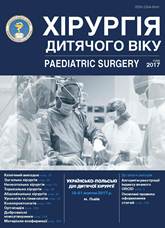Influence of the anococcygeal ligament status on function of an anal sphincteral apparatus
DOI:
https://doi.org/10.15574/PS.2017.56.103Keywords:
anococcygeal ligament, coccygectomy, rectum, anorectal angleAbstract
Anococcygeal ligament (ACL) determines the spatial anorectal configuration due to traction and counter-traction mechanism of anal continence, and namely due to compression and displacement of the rectum characterized by its displacement with respect to points of fixation to osteoligamentous apparatus of the small pelvis, and that is why any surgical intervention, which includes removing even a small component of this complex, inevitably leads to functional disturbance of continence after the intervention.Objective: to determine functional disorders of anal sphincter apparatus in case of ACL damage or its plastic surgery.
Material and methods. We have conducted a retrospective study of the treatment outcomes in patients who were treated in the clinic, 15 of them underwent coccygectomy with ACL resection, and 13 patients had ACL plasty. By creating a spatial mathematical model of ACL function it was established that in case of its damage the anorectal angle can be decreased up to +63°, which leads to functional disorders of distal segments of large intestine.
Results. The conducted studies confirmed that the main component of preventing defecation disorders in this group of patients must be the intraoperative removal of rectococcygeal cavity with ACL plastic surgery in order to repair the continuity of musculoligamentous apparatus by imitating its anatomical fixation.
Conclusions. Repair by imitating anatomical fixation of anococcygeal ligament junction after intraoperative damage allows creating conditions for its physiological functioning, which, in its turn, helps to prevent defecation disorders.
References
Babkin AV, Egorova ZV. (2012). Modern approaches to the treatment of cohorts. ARS Medica. 4: 3-11.
Bondar GV, Yuasheev VK, Sovpel OV, Sovpel IV. (2013). Magneto-resonance imaging of damages of the retaining structures of the anorectum after oncological proctology. Surgery of Ukraine. 3: 59-64.
Mokhov OI. (2006). Treatment of posttraumatic coccyx injury in children. Sitenko Institute of pathology of the spine and joints AMN of Ukraine. Kharkiv: 19.
Smakaev RU, Mukhamedrakhimov RR, Krusmyan AV, Kharisova LR. (2015). The use of radiation methods in the diagnosis of coccyx traumas. Bulletin of the Bashkir State Medical University. 5: 55-61.
Levin MD, Nikiforov AN, Varda YaF. (2012). Surgical treatment of infants with low fistulous anorectal anomalies. Health care. 2: 53 – 59.
Bodnar OB, Dzham OP, Prytula VP, Vatamanesku LI, Bodnar HB. (2016). Khronichnyi kolostaz u ditei (khirurhichnyi pohliad na problemu). Chernivtsi: BDMU: 199.
Shestakov AM, Sapin MR. (2011). Rectum and anal canal. Moscow: GEOTAR-Media: 128.
Kaushal R, Bhanot A, Luthra S. (2005). Intrapartum coccygeal fracture, a cause for postpartum coccydynia: a case report. Journal of surgical orthopaedic advances. 14; 3: 136 -137. PMid:16216182
Downloads
Issue
Section
License
The policy of the Journal “PAEDIATRIC SURGERY. UKRAINE” is compatible with the vast majority of funders' of open access and self-archiving policies. The journal provides immediate open access route being convinced that everyone – not only scientists - can benefit from research results, and publishes articles exclusively under open access distribution, with a Creative Commons Attribution-Noncommercial 4.0 international license(СС BY-NC).
Authors transfer the copyright to the Journal “PAEDIATRIC SURGERY.UKRAINE” when the manuscript is accepted for publication. Authors declare that this manuscript has not been published nor is under simultaneous consideration for publication elsewhere. After publication, the articles become freely available on-line to the public.
Readers have the right to use, distribute, and reproduce articles in any medium, provided the articles and the journal are properly cited.
The use of published materials for commercial purposes is strongly prohibited.

